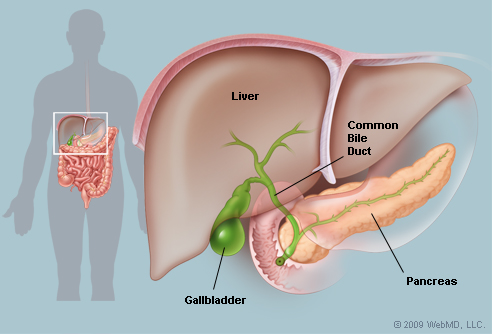What and where is the gall bladder?
The gallbladder is a pear shaped structure that lies underneath of the liver. Its function is to store and concentrate bile (a substance that helps in digestion). Bile is produced by the liver and deliver it to the small intestine. The bile mixes with the food and aids in the absorption of fats and certain vitamins that are dissolved in the fats.

Diseases of gall bladder
Gall stone:
What are gallstones?
Gallstones are solid stones formed in the gall bladder from cholesterol, bile salts and calcium. They can vary in size from a few millimetres to a few centimetres.
What causes gallstones?
Gallstones are formed when bile contains too much cholesterol. The excess cholesterol forms crystals from which gallstones are made.
Who is at risk of developing gallstones?
Gallstones are seen in all age groups but they are rare in the young. The possibility of developing gallstones increases with age.
The following groups are considered to be at increased risk: obese people, people with a high blood cholesterol level, women who take drugs containing oestrogen, eg contraceptive pills., people with diseases such as chronic intestinal inflammation (Crohn’s disease and ulcerative colitis).
What are the symptoms of gallstones?
It is thought that approximately two thirds of patients will have no trouble at all from their gallstones and only one third of patients will at some time experience symptoms. These symptoms can be extremely variable but usually present in two ways. Acute cholecystitis or chronic cholecystitis. Both the conditions may lead to complications if not treated properly.
Acut cholecystitis:
Acute cholecystitis is a sudden inflammation of the gallbladder that causes severe abdominal pain.
In 90% of cases, acute cholecystitis is caused by gallstones in the gallbladder. Other causes include infection (acalcular cholecystitis) and rarely tumors of the gallbladder.
Acute cholecystitis occurs when bile becomes trapped in the gallbladder. The buildup of bile causes irritation and pressure in the gallbladder. This can lead to infection and a hole (perforation) , Empyema (pus in the gallbladder),Gangrene (tissue death) of the gallbladder and Peritonitis (inflammation of the lining of the abdomen), which is a serious condition.
Clinically patient will be ill looking, tenderness in the right side of upper abdomen .
Abdominal ultrasound will show thick wall, distended gall bladder with fluid accumulation around the gallbladder or in the abdomen. Complete blood count (CBC) may show a higher then normal white blood cell count.
Liver function may be altered with raised serum bilirubin level. Abdominal ultrasound may show the stone as acoustic shadow, distended and thick wall gall bladder. Abdominal CT scan will reveal thick gallbladder with some fluid collection around the gall bladder.
How are gallstones treated?
Gallstones which causes symptom , need treatment. Treatment is the removal of gall bladder and gallstone (s )together – this is called cholecystectomy.
There are two ways of removing the gall bladder (Cholecystectomy), one is laparoscopic and another open surgical method. Nowadays more than 90 per cent are removed by laparoscopic or keyhole surgery.
This involves making four small cuts less than 1cm long in the abdomen and the use of a tiny camera inserted though one of these cuts to see the gall bladder.
Other instruments are placed in the abdomen through the other cuts. If the operation is successful most patients are able to go home the day after surgery and return to normal everyday activities within two weeks.
In some cases laparoscopic surgery is considered too dangerous or too difficult and it is then necessary to do a traditional or ‘open’ cholecystectomy. This involves making a cut in the abdomen .. The patient will usually need to stay in hospital for at least five days.
Chronic cholecystitis
This is a chronic inflammation of the gall bladder which may be due to stone(s) or inflammation (acalcullar cholecystitis) . Sometimes gall bladder tumor may be associated with the inflammation of gall bladder (cholecystitis) .
Recurrent episodes of pain in the upper abdomen, or just below the ribs on the right side, pain which becomes worse over an hour and then stays the same and may spread to the right shoulder or between the shoulder blades.
Treatment is the cholecystectomy.
Gallbladder tumor (Gallbladder cancer)
Cancer of the gallbladder is more common in women then men . It is the third common cancer in women . Gall stone is present in the gallbladder in about 70 % to 80% of cases. Most of the time gall bladder cancer is asymptomatic and grows silently. That’s why detected in late and complicated stage. At that stage the cancer is beyond the scope of curative treatment. Sometimes it is detected after removal of gall bladder (cholecystectomy) for gall stone, or other conditions.
The symptoms of gallbladder cancer may be obscured by symptoms of gall stone or cholecystitis.Abdominal discomfort, dyspepsia, feeling of abdominal mass and jaundice may be the presenting symptoms.
Abdominal ultrasound is the most important initial diagnostic tool, which may show soft tissue mass in the gall bladder.CT scan with contrast film shows contrast enhancement of the gallbladder mass. Tumor marker like CA.19-9 may be elevated.
Certain conditions of gall bladder needs careful evaluation: they are porcelain gallbladder (calcification of gallbladder wall),large polyp (s), soft tissue mass in the gall bladder and unusually thick wall gallbladder.
Gallbladder cancer spread through stages. ( one through five).
If it could be diagnosed in the early stage, then radical surgery is the definitive treatment strategy. It involves removal (resection) of segment IVB &V of liver along with cancerous gallbladder enemas.
In the advanced stage palliative stenting of bile duct by endoscopic means to relive jaundice is the option. However, if endoscopic procedure is not feasible due to blockage and narrowing of duodenal channel , then palliative by pass surgery as hepatico jejunostmy and gastrojejunostomy may needed to relieve bilary and duodenal blockage .
Chemotheraphy have limited role.